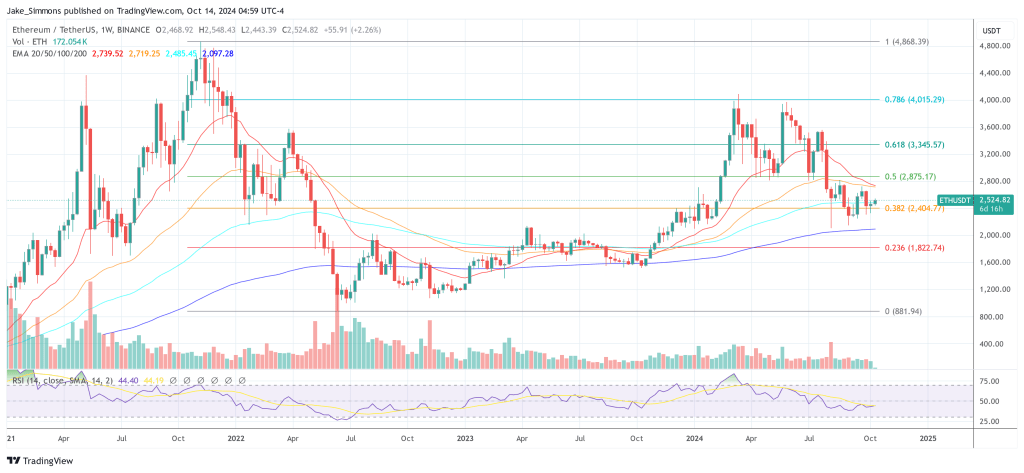In a blog post released on October 14, Ethereum co-founder Vitalik Buterin highlighted technical improvements to the proof-of-stake (PoS) system and announced possible future enhancements to the Ethereum protocol. Outlined about gender. This post, titled “The Possible Future of the Ethereum Protocol, Part 1: Merging,” delves into strategies to improve stability, performance, and accessibility while addressing the risks of centralization.
First, Buterin reflected on Ethereum's successful transition from proof-of-work to proof-of-stake, also known as “merging,” about two years ago, saying, “This proof-of-stake is a combination of stability, performance, and centralization risk. ” However, he stressed that “there are still some key areas where proof of stake needs to be improved.”
Future enhancements to Ethereum
One of the main focuses of this post is reducing minimum staking requirements to achieve single slot finality and democratize participation in the network. Currently, it takes 2-3 epochs (about 15 minutes) to complete a block and requires a minimum of 32 ETH to become a validator. Buterin highlights the contradiction between minimizing staking requirements, reducing finality time, and minimizing node overhead.
“Today, it takes 2-3 epochs (about 15 minutes) to complete a block and requires 32 ETH to become a staker,” he wrote. He identified the goal of finalizing blocks in one slot and allowing validators to stake with as little as 1 ETH. “Poll after poll repeatedly shows that the main factor preventing more people from solo staking is a minimum of 32 ETH,” Buterin points out.
To address these challenges, he describes several approaches. One is the implementation of a better signature aggregation protocol, potentially using zero-knowledge proofs (ZK-SNARKs) to process signatures from millions of validators in each slot. Another approach is to introduce an orbit committee. This is a mechanism in which a randomly selected medium-sized committee finalizes the chain while preserving attack cost characteristics. “Orbit takes advantage of the existing heterogeneity in validator deposit sizes to give smaller validators their due role while achieving the highest possible economic finality,” he explained. I will.
Buterin is also considering creating a two-tier staking system with different deposit requirements. In this system, only the higher depositing tiers are directly involved in providing economic finality. He acknowledges that “risk is highly dependent on the specific rights that the lower staking tiers get” and that certain designs may lead to centralization.
Buterin proposes implementing the Single Secret Leader Election (SSLE) protocol to address security vulnerabilities related to denial of service (DoS) attacks against known validators. “The best way to solve the DoS problem is to hide the information about which validator will generate the next block, at least until the moment the block is actually generated,” he said.
The SSLE protocol uses cryptographic techniques to create a “blind” validator ID, allowing only the owner of the blind ID to generate valid evidence to propose blocks without revealing their identity to others. I will make it possible. But Buterin acknowledges the challenges. “We appreciate that Ethereum is a reasonably simple protocol and don’t want it to get any more complicated. Specification codes are added and new assumptions are introduced for complex cryptography.
He also looked at ways to reduce Ethereum transaction confirmation times from the current 12 seconds to 4 seconds, highlighting the value of reducing confirmation times to improve user experience and support decentralized layer 2 solutions. emphasized. Strategies include shortening slot times and allowing proposers to publish preconfirmations during the slot. However, Buterin cautioned about the potential risks of centralization and the need for proper incentives, saying, “If you add a mechanism to separate the authenticator and proposer, you don't need SSLE for execution blocks. , because you can rely on specialized block builders.”
Buterin also touched on additional key areas, such as his 51% attack recovery. He suggests that while full automation is impossible, “partial automation can be achieved.” […] At the very least, you need to make sure that the attacking bad guys can't get a complete victory right away. He is also considering increasing the quorum threshold for block finalization from 67% to 80% to improve security, adding, I think that's much more healthy.”
Buterin concludes his blog post by warning of the importance of preparing for the potential threat of quantum computers that can break through current cryptographic systems. “This justifies conservatism in the performance assumptions of proof-of-stake designs, and also calls for a more aggressive approach to developing quantum-resistant alternatives.”
At the time of writing, ETH was trading at $2,524.

Featured image from Bloomberg, chart from TradingView.com

